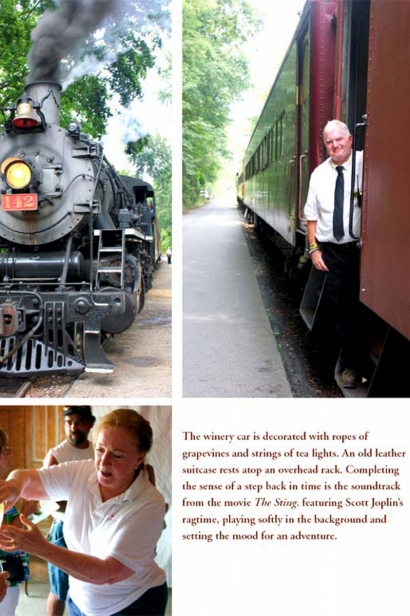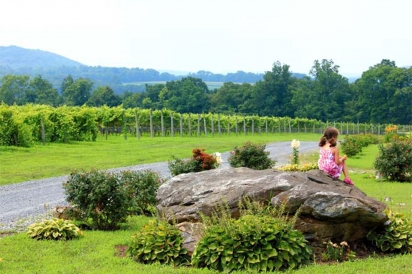The Wine Train of Warren County
Long before you see the Warren County Winery Train coming round the bend, you hear its whistle and the roar of its steam engine clanking down the track. When the train appears, a child yells out, "I see it!" Engine No.142, pulling vintage passenger cars, chuffs into the Lehigh Junction Station in Phillipsburg like the grande dame of the railroad that she still is.
As we line up to board, experienced trainmen jump off, placing step stools in front of the boarding entrances, greeting us and checking our tickets. Those of us with winery tickets are directed to the last car, where another trainman awaits. As we board, he asks if we've been to Villa Milagro Vineyards before. He assures us we're in for a treat.
The winery car is decorated with ropes of grapevines and strings of tea lights. An old leather suitcase rests atop an overhead rack. Completing the sense of a step back in time is the soundtrack from the movie The Sting, featuring Scott Joplin's ragtime, playing softly in the background and setting the mood for an adventure. No. 142 is one of two operating steam engine locomotives in New Jersey, says our guide for the afternoon, Ilene Doran. (The other is the Black River & Western Railroad, operating out of Ringoes.) Built in 1988 by the Tangshan Locomotive Works in China, it was patterned after the trains of a bygone era. The Delaware River Railroad Excursions, the organizer of today's ride, is a nonprofit that hosts themed train outings, ranging from the Dinosaur Train to the Polar Express. But today is all about wine.
Though New Jersey may not yet be one of the biggest wine-producing states, it's quickly becoming a popular wine destination. Doran contends that Jersey makes some of the best, with Villa Milagro's wines a prime example. The vineyard is owned by Dr. Audrey Cross Gambino and her husband, Steve Gambino. "They spent two years reclaiming the soil using organic methods," Doran says, "and another five years to get the grapes to maturity."
The train winds along the scenic Delaware, offering spectacular views of both the river and the surrounding area. Along the way, an occasional farmhouse, cottage or farm appears, as well as a few fishermen. As we travel, Doran points out significant landmarks, including the Delaware Canal State Park and the historic stone lime kilns dating to the 1850s. After the train slows, a waiting school bus completes our short ride to the vineyard where Audrey Cross Gambino and Commander Cody, the couple's friendly German shepherd, greet us.
Our tour begins in the vineyard with Cross Gambino giving us a few minutes to take in the view. It's majestic. Sitting high on a ridge overlooking the Delaware and Musconetcong rivers, the 11- acre vineyard on 104 acres of preserved farmland offers a panoramic view of two states and four counties: Warren and Hunterdon counties in New Jersey and Bucks and Northampton in Pennsylvania. The vineyard's high altitude and its proximity to the two rivers below create a desirable microclimate for growing grapes.
Moisture is the biggest challenge in growing grapes on the East Coast, explains Cross Gambino. But because the vineyard sits on a ridge overlooking the two rivers, the cold air falls, keeping the plants warm at night and reducing the amount of dampness that would have come with cooler air. In addition, the breeze from the rivers help keep the vines dry. Another factor enhancing the vineyard's topography is its southern slope, which allows a maximum amount of sunlight during the day as the sun travels from east to west. In addition, she says, "We planted the rows wider than most [vineyards] so that no vine is ever in shadow."
Cross Gambino follows sustainable and organic viniculture practices, she says, and uses no commercial fertilizers. Instead of spraying with pesticides, she's created a natural habitat for beneficial insects and native birds. A noted nutritionist, lecturer and author who grew up in California, Cross Gambino says she was determined to run the first certified organic winery on the East Coast. But that was before she met black rot, a virulent mildew that attacks grapes grown throughout the region. Keeping the vine branches upright for maximum sunlight and air circulation can help prevent black rot – but the only way to combat it once it's established, she says, is with a nonorganic fungicide.
Before heading to the tasting room, we learn how the hand-harvested grapes are turned into wine. The grapes are first crushed in separate stainless steel vats according to their destination as red or white wine. For red, she says, everything except the stems is used. For white wine, only the juice goes in. Yeast is then added for fermentation. When the fermentation is completed, the grape juice is pumped into tanks in the chill room, a large building kept at 56°. This is where Cross Gambino does her tasting and blending of the varietals to highlight the best profile, flavor and balance of each. The wines are then aged in American oak barrels and, finally, bottled and labeled.
Villa Milagro grows 10 varietals of grapes, two American hybrids and the rest French and Italian. Cross Gambino blends her wines in the style of Old World wines. For our tasting today, she has only four of their wines, explaining with apologies that the other wines they make are either sold out or not ready. In addition, two of their wines are only made once a year. Gracias, a white wine, is released the first of November and is perfect for Thanksgiving fare, she says, and Feliz Navidad, a red wine with the essence of spice, is available from Thanksgiving to Jan. 6.
Our wines are paired with appetizers prepared by Cross Gambino. As is customary in tastings, we start with the lightest white: their Delicado. As its name suggests, it is delicate, light and sweet. A good choice to pair with mild seafood, she says. Next we taste Luz del Sol, also a white. Here there are hints of its Chardonnay origins, with a mild fruitiness from Muscat Canelli grapes. The wine matches well with vegetarian dishes, she says, as well as with poultry and fish. Mostly follows. This is a rich red that represents well its Merlot beginnings, tempered with "a splash of Cabernet Franc." Like most Merlots, it's very food friendly. Our final wine, and the most powerful, is Sombra. Because of its port-like style, she says, it "needs to be sipped with food." It pairs especially well with steaks or Gorgonzola and Camembert cheeses, she says.
Before we depart, Cross Gambino says that on her wish list when looking for the ideal property for her vineyard was that it be within the sound of a train's whistle. Shortly after starting Villa Milagro, which means "house of miracles" in Spanish, she was able to check that off.
There's something about the sound of a train's whistle – with its promise of romance and adventure, of halcyon days gone by – that holds special enchantment. And when you combine a steam engine train ride with a visit to one of New Jersey's great wineries for a tour and tasting, you have the pairing for a perfect day.
Editor's note: The Warren County Winery Train runs weekends through Oct. 27. Get more info at warrencountywinerytrain.com.









